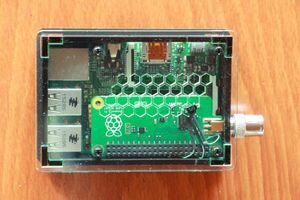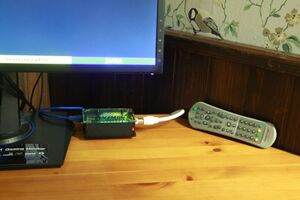Raspberry Pi
Introduction
The Raspberry Pi Model 2 and 3 are based on a VideoCore IV GPU that was more or less created for VDR. It supports hardware accelerated decoding of MPEG-2 and H.264 streams. The power consumption of the system is rather low, and passive cooling may be sufficient.
The Raspberry Pi Model 4 and Model 5 are based on newer versions of the VideoCore GPU and are more powerful.
The Raspberry Pi 5 includes a real time clock and might allow Rtcwake to work.
You may use the Rasbperry Pi as a front-end, streaming video from a separate server on your local area network, or you could create a minimal stand-alone system. Here are a few options:
- Input_devices:
- Pi TV HAT (Sony CXD2880 for free-to-air DVB-T and DVB-T2)
- USB based tuner
- IPTV streaming over Ethernet
- LIRC receiver:
- TSOP38238 connected to the GPIO header
- Something via a USB based tuner
- Something behind a separate microcontroller that could also feature power-on by timer or infrared remote control
- Storage:
- USB-powered SSD; see Systemd how to make VDR auto-start when storage is plugged in
- NAS via Ethernet
- Case:
- Minimal: Any Pi case, with discrete components attached via cables
- Intermediate: The TV HAT case, with the IR receiver sticking out of a vent hole, external USB-powered SSD
- Maximal: Everything built in, including storage and a mains power supply
gpio-ir driver
You can connect a TSOP38238 infrared remote control receiver to the GPIO header: 3.3V, ground, and GPIO 18 (or 17). You can enable the hardware by adding the following line to /boot/config.txt:
dtoverlay=gpio-ir,gpio_pin=18
After rebooting, the hardware should be available in /dev/lirc0. Install the package ir-keytable and configure /etc/rc_maps.cfg, as noted in LIRC.
If you are using the Pi TV HAT, the infrared receiver can be connected via loose wires to solder pads next to the GPIO header. Be careful when soldering.
Links
| [1] | https://www.raspberrypi.com/products/raspberry-pi-tv-hat/ | Raspberry Pi TV HAT |
| [2] | https://thepihut.com/blogs/raspberry-pi-tutorials/tv-hat-case-for-raspberry-pi-assembly-guide | TV HAT case |
| [3] | https://learn.adafruit.com/using-an-ir-remote-with-a-raspberry-pi-media-center | How to connect a TSOP38238 receiver to a Raspberry Pi |
| [4] | https://github.com/j1rie/IRMP_STM32/ | IRMP on STM32 - a USB IR receiver/sender/powerswitch with wakeup-timer |
| [5] | https://www.vdr-portal.de/forum/index.php?thread/133346-m3d1-pi/ | M3d1@Pi case |


